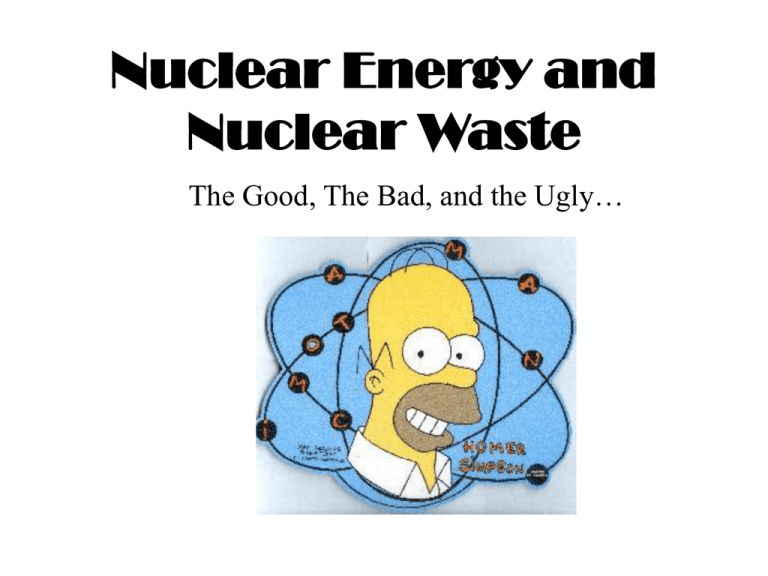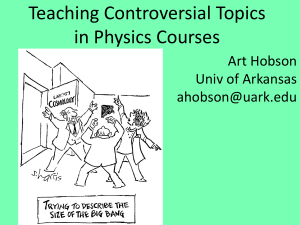Supplementary_Notes_files/nuclear waste 1
advertisement

Nuclear Energy and Nuclear Waste The Good, The Bad, and the Ugly… What is Nuclear Energy? • Nuclear energy is the energy that exists within the nucleus of an atom. • There are 2 types of Nuclear Energy: •Nuclear fission is the splitting of a large nucleus, releasing HUGE amounts of energy. •Nuclear fusion is the combining of smaller nuclei to form heavier nuclei, releasing HUGE amounts of energy. How is Nuclear Fission Energy produced? If a Nuclear Reaction is not controlled… Nuclear Energy must be harnessed if used to make energy. • Nuclear reactions in a nuclear power plant occur at a controlled, manageable pace and release energy slowly. • Heat is generated and used to boil water, creating steam. The steam turns turbines which rotate electric generators, creating electricity. • Steam is released from the cooling towers. • (click on picture for more info) How does a Nuclear Power Plant Work? How much energy is produced? • Nuclear power is an extremely rich energy source. • One gram of Uranium235 delivers as much energy as 3.5 metric tons of coal!!! • One in every 5 houses in the U.S. is supplied with nuclear energy. Where are Nuclear Power Plants located? Pros for Nuclear Power • Rich energy source. • 1 gram of Uranium-235 delivers as much energy as 3.5 metric tons of coal. • Reactors run for years without refueling or being shut down and need little maintenance. • No air pollution! Cons about Nuclear Power • Produces Radioactive Waste • There is no permanent longterm disposal site for commercial nuclear waste. • There is a relatively short supply of 235U (only enough left for 100~200 years) • Nuclear Power Plants are expensive to build. • Minor maintenance problems can be very expensive to fix. • Safety concerns!!! Potential for Disaster! • Chernobyl meltdown in the former Soviet Union. – Hundreds died from radiation exposure. – Thousands contracted cancers from high levels of radiation exposure. A Close Call at Home!!! • The most serious nuclear accident in the U.S. occurred in 1979 at Three Mile Island nuclear power plant in Pennsylvania. • A small amount of radioactive gas escaped the containment structure. Nuclear Waste • Plutonium, cesium, strontium, and other “ium” elements created in a nuclear reactor emit dangerous radiation that can literally knock electrons off the atoms of our cells, disrupting or destroying cell function or even causing cells to mutate into cancer cells. • Radioactive elements emit radiation because they are unstable; they’d rather be something else. • They achieve this by going to pieces; emitting particles and waves billions of times per second. This process is called a half-life. What is a Half-Life? • Every radioactive element has a half-life • Half-life is the time it takes for half of its atoms to decay. • Half-lives range from a fraction of a second to billions of years – 4.5 billion for uranium 238. • The longer the half-life, the less intense the radiation. • After 10 half-lives, an element is usually harmless Types of Waste •High-Level Waste •The most dangerous radioactive waste •Spent fuel comes from nuclear reactors (52,000 tons) • liquid and solid waste from plutonium production (91 million gallons). •About 70 percent of the available storage space is now filled with used fuel assemblies at Turkey Point. Types of Waste Transuranic Waste – Includes clothing, tools, and other materials contaminated with plutonium, neptunium, and other man-made elements heavier than uranium. (11.3 million cubic feet) Types of Waste • Low and Mixed Low-Level Waste – Includes radioactive and hazardous wastes from hospitals, research institutions, and decommissioned power plants (472 million cubic feet) – Turkey Point produced annually on average about 2,500 cubic feet of low-level waste. This amount of waste could be contained within an area about the size of a 30'x30' room. Types of Waste Uranium Mill Tailings •Residues left from the extraction of uranium ore (265 million tons).





![The Politics of Protest [week 3]](http://s2.studylib.net/store/data/005229111_1-9491ac8e8d24cc184a2c9020ba192c97-300x300.png)

